Photo courtesy of Zoë Vavrek.
The Estuary Program partners with the California Conservation Corps, Creek Lands Conservation, and the City of San Luis Obispo to host two Watershed Stewards Program (WSP) Corpsmembers as part of the San Luis Obispo Steelhead Initiative (SLOSI) placement site. The Corpsmembers receive a breadth of experience during their term of service and support capacity-building for all four organizations.
During their time with the Estuary Program, WSP Corpsmembers support various field-based efforts, including intertidal eelgrass monitoring. This work takes the Corpsmembers out into the Morro Bay estuary, often via kayak or paddle board.
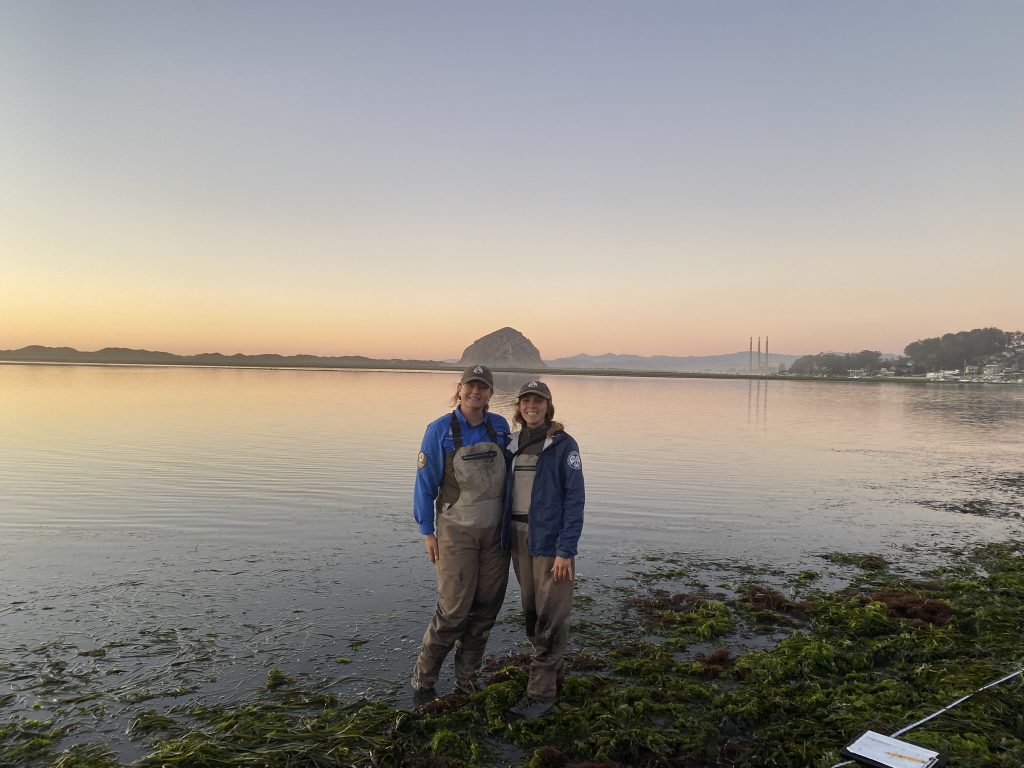
Working alongside Estuary Program staff, WSP Corpsmembers Anya and Zoe have encountered a variety of intriguing species within the intertidal eelgrass beds. Invertebrates like nudibranch and isopods are not only fascinating to look at but are critical for maintaining ecosystem balance. By contributing to nutrient cycling, algae control, and the food web as prey for larger animals, these invertebrates are integral to the health of our coastal ecosystems.
Meet the Invertebrates
The following section is written by Watershed Stewards Program Corpsmember Zoë Vavrek.
Encountering an unfamiliar creature often raises many questions, such as: What is this species called? How common is it? What does it eat and where does it live? My experiences working in the intertidal zone with Estuary Program staff sparked many of these same questions.
To find answers, I took numerous photos during fieldwork and uploaded them to iNaturalist, an app that allows the public to share photos of plants and animals for identification by fellow naturalists. I created the identification cards below using my own photos along with resources available from iNaturalist.
Eelgrass Isopod (Pentidotea resecata)
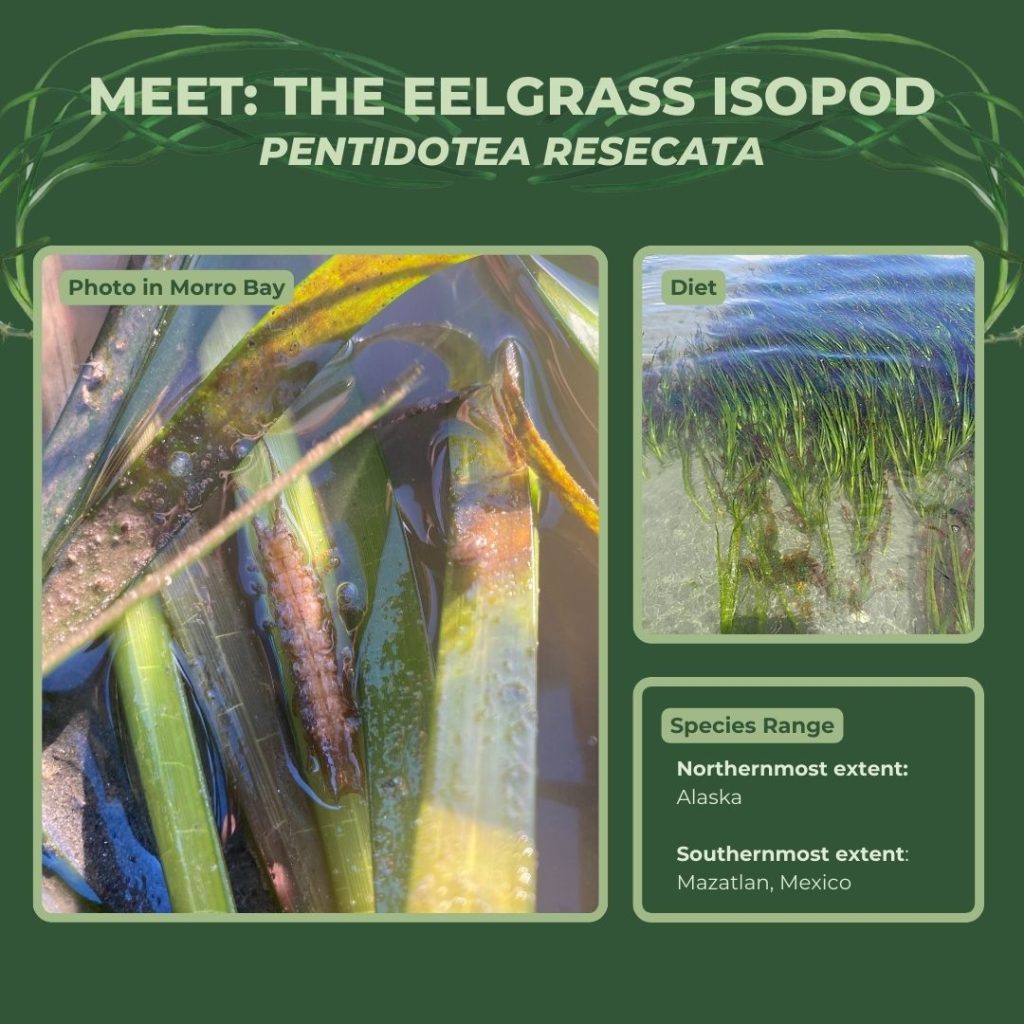
Isopods are crustaceans in the order Isopoda commonly found in estuaries. Isopods live in eelgrass and different types of kelp, and their color varies based on which type of habitat they reside in. Kelp isopods often have a brownish hue while eelgrass isopods have a greener hue. Eelgrass isopods consume primarily algae and eelgrass and must live in saline waters. Moving these isopods out of salty ocean water is often deadly to them as they are very sensitive to changes in salinity, only lasting a little over an hour in freshwater (Leno, 2002). Eelgrass isopods are found from Alaska to the tip of Baja California.
Opalescent Nudibranch (Hermissenda opalescens)
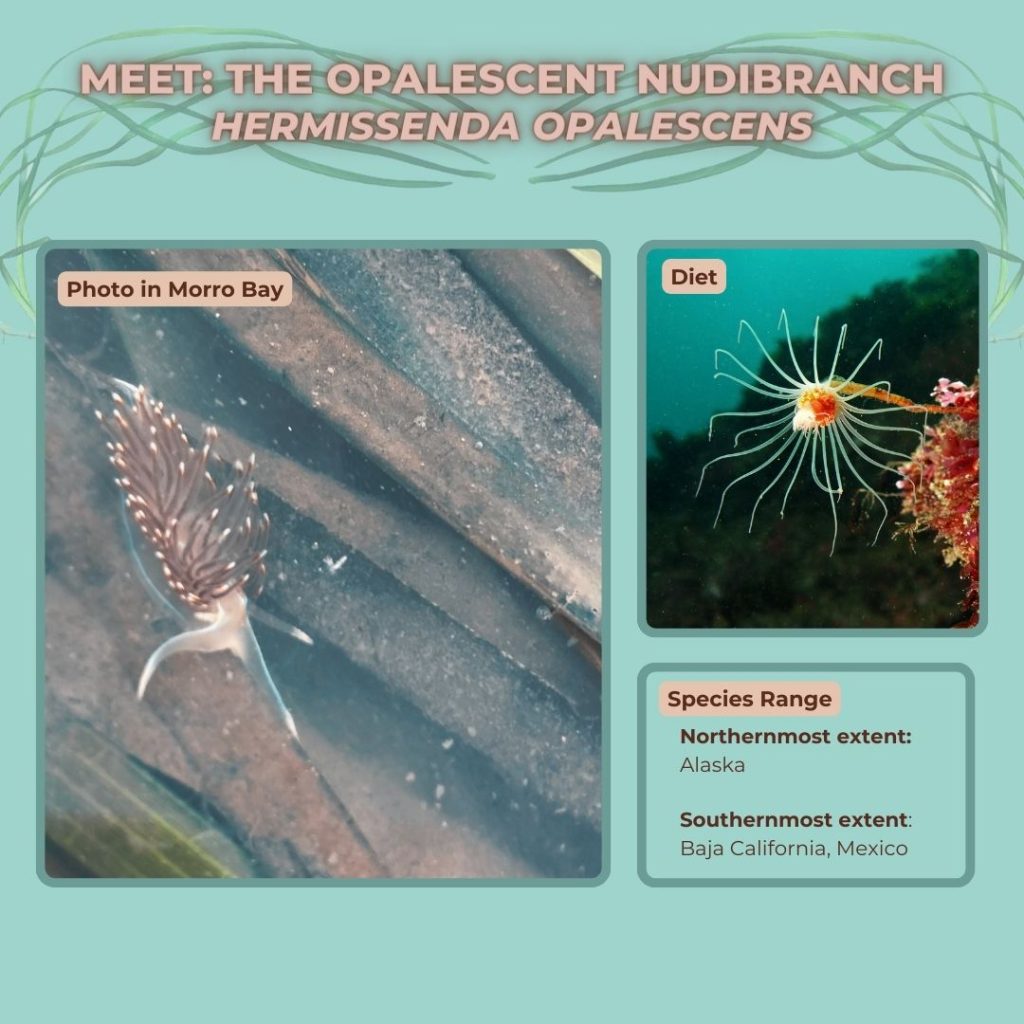
Opalescent nudibranchs are in the family Facelinidae and range from Alaska to Baja California. These beautiful sea slugs eat prey that sting (hydroids and anemones) and keep some of the stingers to defend themselves from predators (Monterey Bay Aquarium, 2021). To learn more about this fun creature check out the Estuary Program blog post here.
California Aglaja (Navanax inermis)
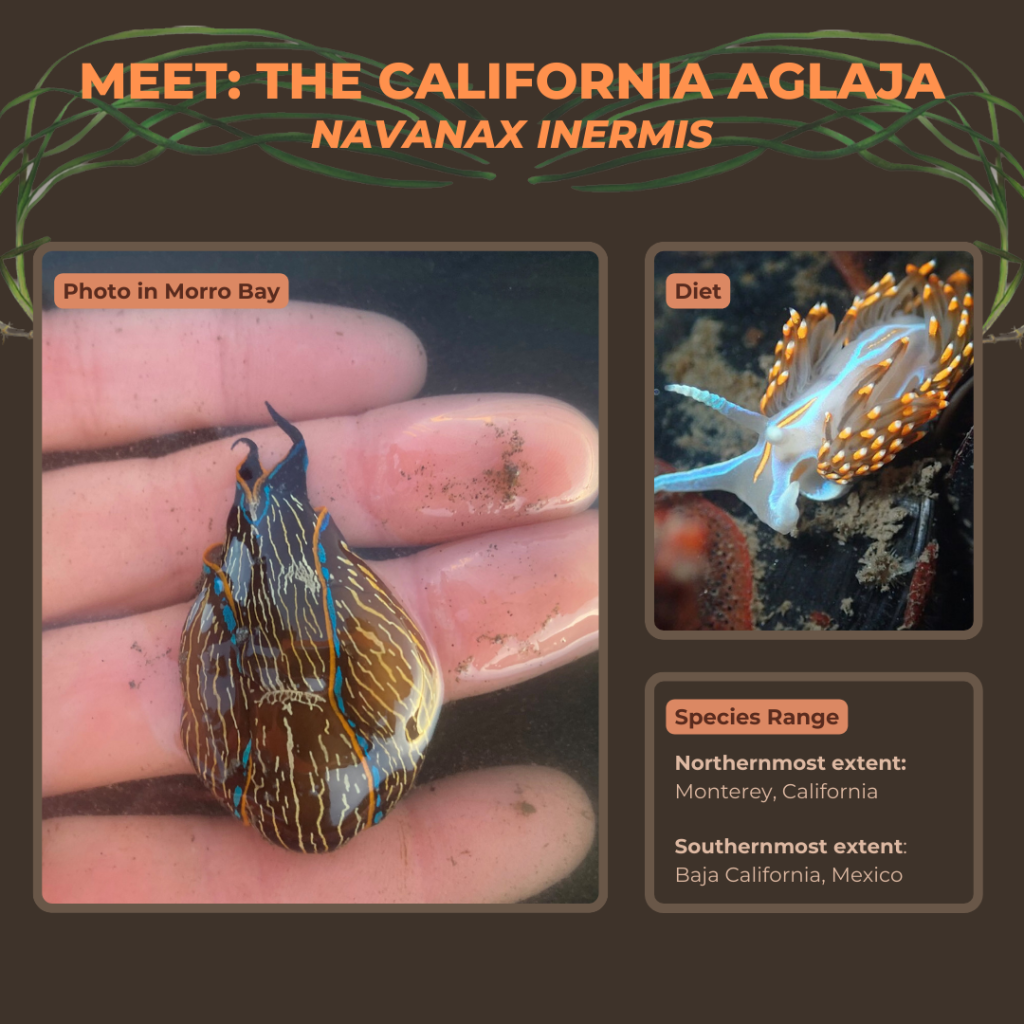
The California aglaja are a type of sea slug. Although they may look like nudibranchs, they are from the older lineage of headshield slug and bubble snail order, Cephalaspidea. These colorful slugs can be found from Monterey Bay south to Baja California, Mexico (Paine, 1965). Aglaja or Navanax are a predatory species that feed on other sea slugs like bubble shells and nudibranchs. This sea slug does not visually scope out its prey but uses chemoreceptors to detect the slime of their prey (iNaturalist, n.d.).
Monterey Dorid (Doris montereyensis)
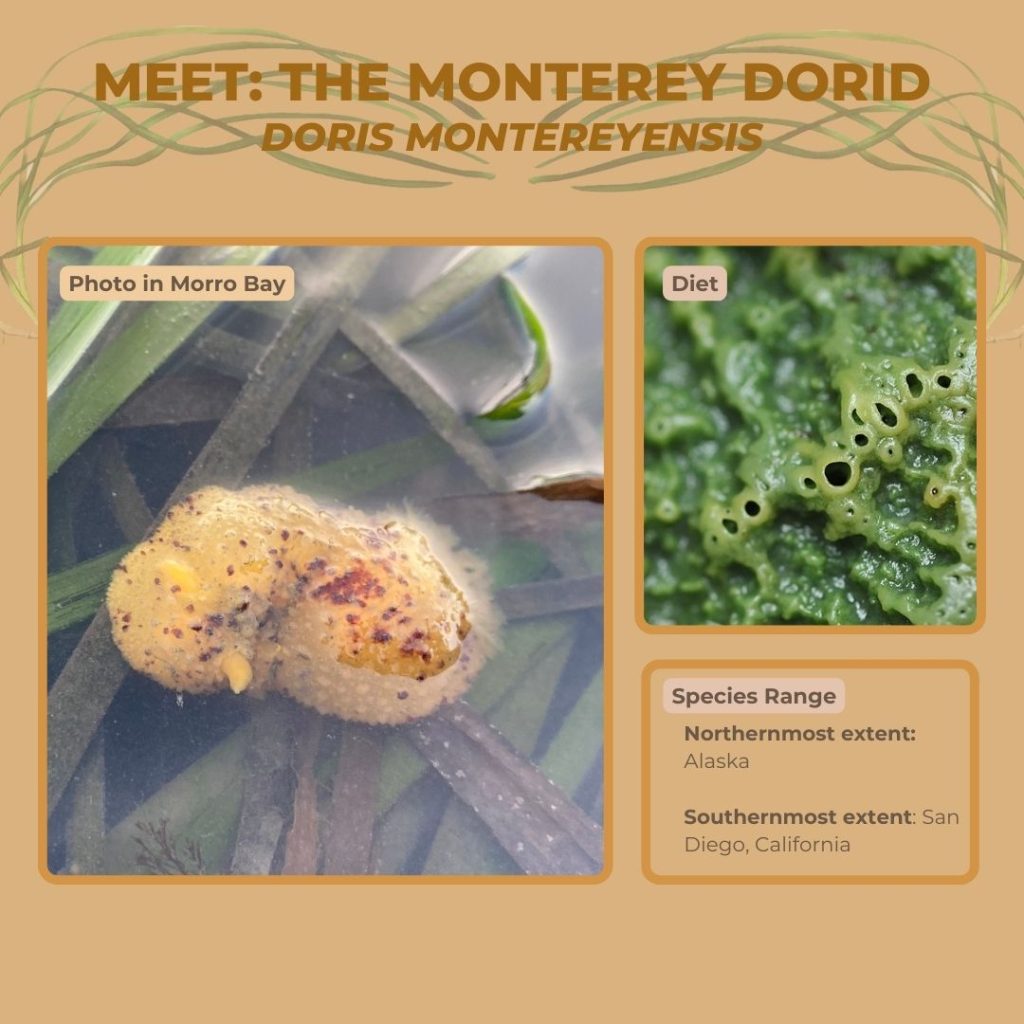
The Monterey dorid is a type of sea slug that is a nudibranch in the family Dorididae, also called the sea lemon family. They can be found from Alaska to San Diego, California. They feed on sponges like Haliclona panicea also known as the crumb-of-bread sponge (Cowles, 2005). They lay their eggs in a ribbon that can contain up to two million eggs (Brietzke, Fretwell, and Starzomski, 2016).
Bay Ghost Shrimp (Neotrypaea californiensis)
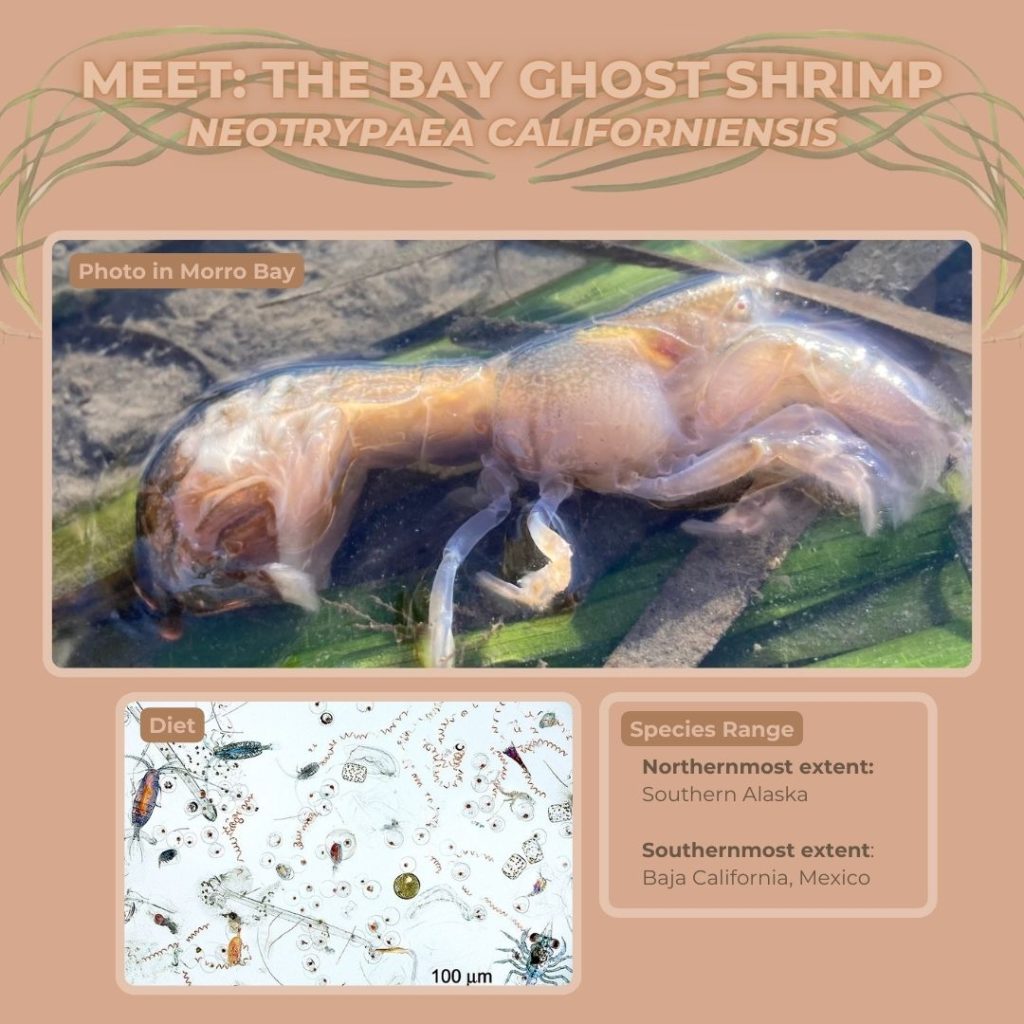
Bay ghost shrimp are a pale, burrowing shrimp that are part of the Callianassidae family. These shrimp are considered ecosystem engineers because their burrows create habitat for a range of organisms including fish, worms, and mollusks. Their burrowing holes can also help oxygen reach deeper sediment layers. Ghost shrimp primarily consume plankton and debris which they collect on the hairs of their legs as they burrow (iNaturalist n.d.). Ghost shrimp can be found along the Pacific Coast of North America, from Alaska to Mexico (Cowles, 2007).
Add Your Own Observations
Applications like iNaturalist not only teach you about the environment and wildlife around you, but also allow you to record your own observations. For more information about getting involved, visit https://www.inaturalist.org/.
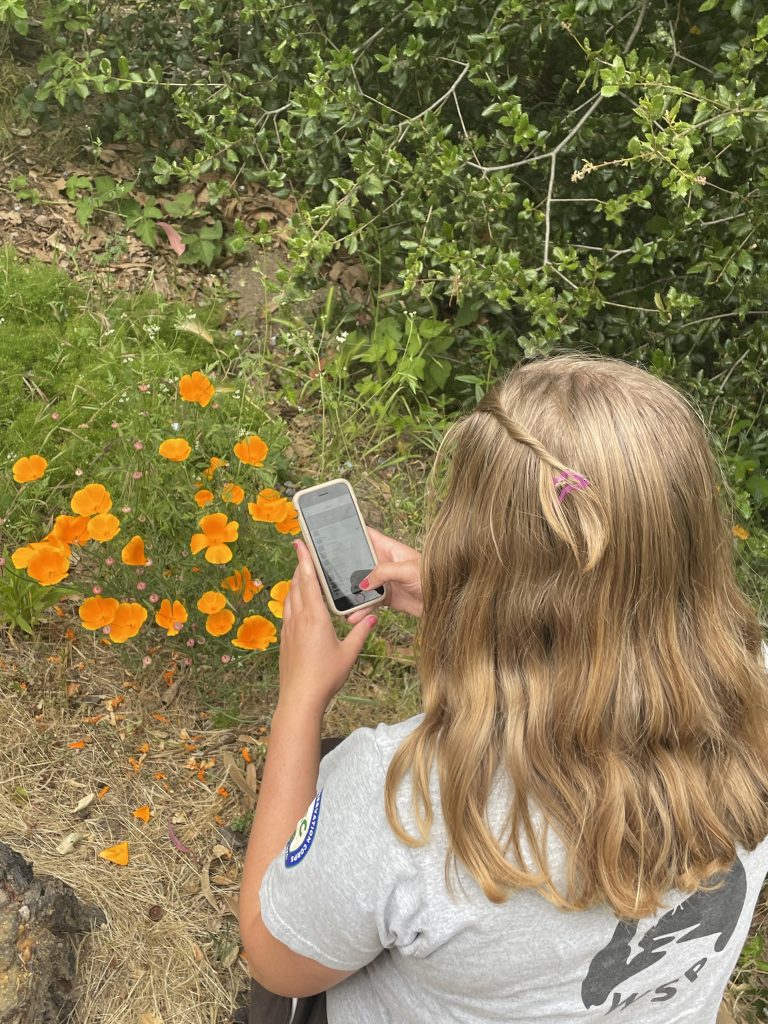
References
Brietzke, Chanda, Kelly Fretwell, and Brian Starzomski. 2016. “Monterey Sea Lemon, Doris Montereyensis.” Biodiversity of the Central Coast. 2016. Accessed May 29, 2024. https://www.centralcoastbiodiversity.org/monterey-sea-lemon-bull-doris-montereyensis.html.
Cowles, Dave. 2005. “Doris Montereyensis.” Inverts.wallawalla.edu. Accessed May 29, 2024. https://inverts.wallawalla.edu/Mollusca/Gastropoda/Opisthobranchia/Nudibranchia/Doridacea/Archidoris_montereyensis.html.
Cowles, Dave. 2007. “Neotrypaea Californiensis.” Inverts.wallawalla.edu. 2007. https://inverts.wallawalla.edu/Arthropoda/Crustacea/Malacostraca/Eumalacostraca/Eucarida/Decapoda/Thalassinidea/Neotrypaea_californiensis.html.
iNaturalist. n.d. “California Aglaja (Navanax Inermis).” iNaturalist. Accessed May 29, 2024. https://www.inaturalist.org/taxa/49848-Navanax-inermis.
iNaturalist. n.d. “Bay Ghost Shrimp.” iNaturalist. Accessed May 29, 2024. https://www.inaturalist.org/guide_taxa/181273#ref10.
Leno, Heidee. 2002. “Pentidotea Resecata.” Inverts.wallawalla.edu. Accessed May 28, 2024. https://inverts.wallawalla.edu/Arthropoda/Crustacea/Malacostraca/Eumalacostraca/Peracarida/Isopoda/Valvifera/Family-Idoteidae/Idotea_resecata.html
Monterey Bay Aquarium. 2021. “Opalescent Nudibranch.” Montereybayaquarium.org. 2021. Accessed May 29, 2024. https://www.montereybayaquarium.org/animals/animals-a-to-z/opalescent-nudibranch.
Paine, Robert T. 1965. “Natural History, Limiting Factors and Energetics of the Opisthobranch Navanax Inermis.” Ecology 46 (5): 603–19. https://doi.org/10.2307/1935000.
Help us protect and restore the Morro Bay estuary!
- Donate to the Estuary Program today and support our work in the field, the lab, and beyond.
The Estuary Program is a 501(c)3 nonprofit. We depend on funding from grants and generous donors to continue our work. - Support us by purchasing estuary-themed gear from ESTERO. This locally owned and operated company donates 20% of proceeds from its Estuary clothing line and 100% of Estuary decal proceeds to the Estuary Program. Thank you, ESTERO!
- Purchase items from the Estuary Program’s store on Zazzle. Zazzle prints and ships your items, and the Estuary Program receives 10% of the proceeds.
- Subscribe to our seasonal newsletter: Between the Tides!
- We want to hear from you! Please take a few minutes to fill out this short survey about what type of events you’d like to see from the Estuary Program. We appreciate your input!